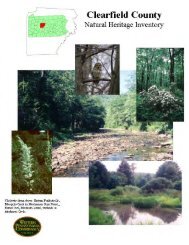Pike CNHI - Pennsylvania Natural Heritage Program
Pike CNHI - Pennsylvania Natural Heritage Program
Pike CNHI - Pennsylvania Natural Heritage Program
Create successful ePaper yourself
Turn your PDF publications into a flip-book with our unique Google optimized e-Paper software.
Invasive Animal Species<br />
In additional to invasive plants, <strong>Pennsylvania</strong> is now home to several exotic species of animals including<br />
mammals, birds, fish, and reptiles. These species directly threaten populations of native animals through direct<br />
competition or predation. Other invasive exotic animals can alter habitats and ecosystems by changing plant<br />
cover or diversity. Some of these invasive animals, such as the Norway rat (Rattus norvegicus), are all too<br />
common encounters in our homes and developed areas.<br />
One of the most significant threats to the biodiversity of<br />
<strong>Pike</strong> County from an invasive animal species is the<br />
hemlock woolly adelgid (Adelges tsugae). This is a<br />
small aphid-like insect that feeds on the leaves of<br />
eastern hemlock trees (Tsuga canadensis). Infestations<br />
of the woolly adelgid appear as whitish fluffy clumps of<br />
feeding adults and eggs along the underside of the<br />
branch tips of the hemlock. This species is native to<br />
Japan and China and was introduced accidentally to<br />
North America around 1924 (McClure 2001). It is<br />
currently distributed from Maine to Georgia and can be<br />
found in over two-thirds of the counties in <strong>Pennsylvania</strong><br />
(PA DCNR 2007).<br />
Hemlock decline and mortality typically occur within four to ten years of initial infestation. The adelgid can<br />
cause up to 90 percent mortality in eastern hemlocks, which are important for shading trout streams,<br />
controlling erosion of steep stream banks, and providing habitat for about 90 species of birds and mammals.<br />
This species has the potential to drastically alter the <strong>Pennsylvania</strong> landscape. Several control options are<br />
currently being tested, but a cost-effective treatment has not yet been found.<br />
The landscape of <strong>Pennsylvania</strong> was drastically altered by chestnut blight (Cryphonectria parasitica), a fungus<br />
probably introduced to North America from infected nursery stock from China in the 1890s. First detected in<br />
New York City in 1904, it had all but wiped out the American chestnut (Castanea dentata) from Maine to<br />
Alabama. American chestnut once comprised one-fourth to one-half of eastern U.S. forests, and was prized as a<br />
food for humans, livestock, and wildlife and for its durable wood. Today, only stump sprouts from infected trees<br />
remain and the resulting canopy gaps have been filled by the chestnut’s associate species, including oaks and<br />
hickories.<br />
The gypsy moth (Lymantria dispar) has caused extensive defoliation of forests in the northeast. This<br />
European moth was intentionally introduced to the U.S. in 1869 as part of a failed commercial silk production<br />
venture. Its main impact is that it defoliates trees, particularly oak species. This defoliation can result in a<br />
reduction in the tree’s growth rate or even lead to the eventual death of the tree.<br />
The European starling (Sturnus vulgaris) is an exotic bird species established in North America during the<br />
mid to late 1800s as part of a plan to introduce all of the birds mentioned in the works of Shakespeare to<br />
Central Park in New York City. It has since spread throughout the United States. In addition to competing<br />
with native bird species for food and space, large flocks of this species destroy fields of crops. The house<br />
sparrow (Passer domesticus) was introduced to several places in the United States in the late 1800’s and has<br />
become widely distributed. In addition to causing crop damage, house sparrows will sometimes kill native<br />
adult cavity nesters and their young or smash their eggs. The house sparrow is partially responsible for a<br />
decline of eastern bluebirds (Sialia sialis) in the United States.<br />
Feral swine (Sus scrofa; also called wild hogs) are potentially one of the most influential upcoming invasive<br />
species for <strong>Pennsylvania</strong> forests. Escaped or deliberately released swine now exist in relatively low numbers in<br />
<strong>Pennsylvania</strong>. Feral swine can impact livestock and cause significant ecological and property damage. This<br />
includes rooting and destruction of native herbs and trees, and the creation of significant erosion from wallowing<br />
Connecticut Agricultural Experiment<br />
Station Archives<br />
Hemlock Woolly Adelgid infestation along a hemlock<br />
branch. This invasive species is currently causing a severe<br />
decline (>90%) of native hemlock stands, an important<br />
habitat type in <strong>Pennsylvania</strong>.<br />
<strong>Pike</strong> County <strong>Natural</strong> <strong>Heritage</strong> Inventory – <strong>Natural</strong> History Overview / 17










